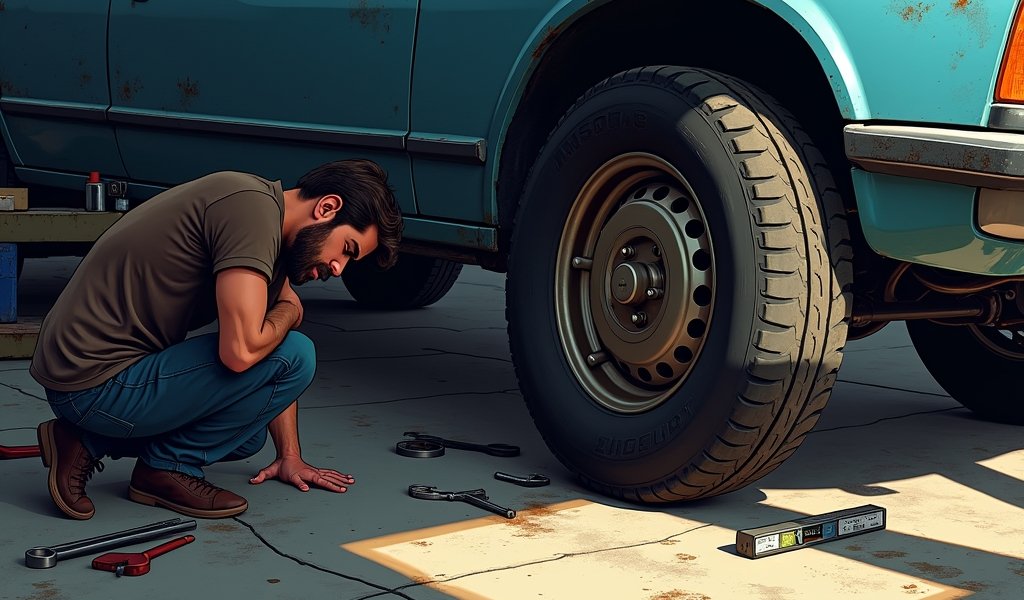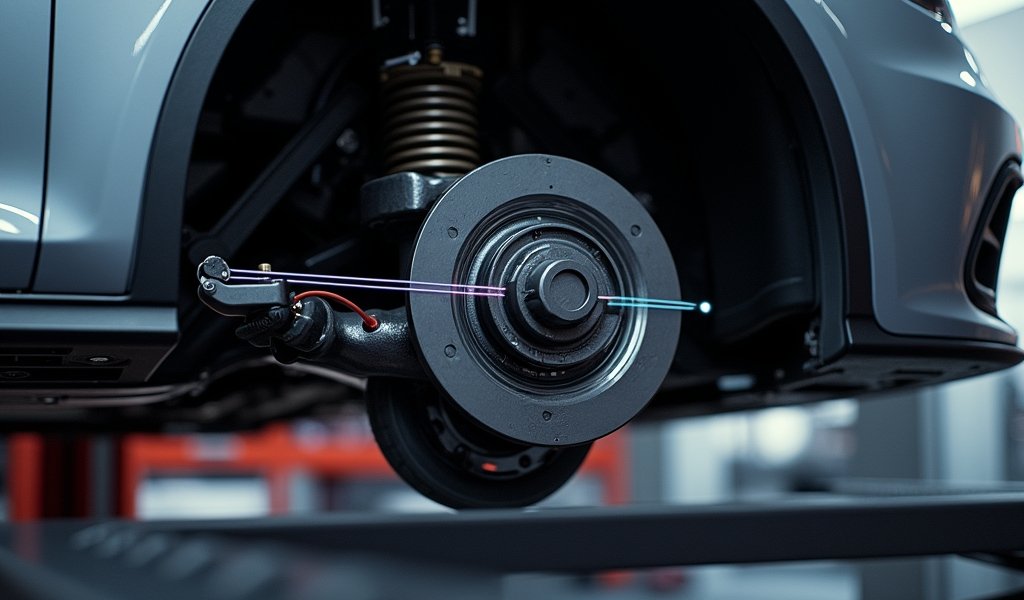Overview
This article provides a detailed guide on measuring and adjusting caster angle—a critical suspension parameter affecting vehicle stability, steering feel, and tire wear. It covers essential tools, step-by-step measurement procedures (both standard and digital methods), result interpretation, common troubleshooting issues, and adjustment techniques to help mechanics and DIY enthusiasts optimize their vehicle’s handling performance.
Table of Contents
- Understanding Caster Angle: What It Is and Why It Matters
- Required Tools for Measuring Caster Angle
- Preparation Steps: Getting Your Vehicle Ready
- Standard Caster Angle Measurement Procedure
- Digital Measurement Methods: Modern Approaches
- Interpreting Your Results: What’s Normal and What’s Not
- Troubleshooting Common Issues During Measurement
- Adjusting Caster Angle: When and How
- Conclusion
- Frequently Asked Questions
Understanding Caster Angle: What It Is and Why It Matters
Have you ever wondered why some vehicles handle so smoothly while others feel unstable? The answer often lies in the caster angle—an essential but frequently overlooked suspension geometry component. As a professional mechanic with years of experience, I can tell you that understanding caster angle is crucial for optimal vehicle performance and safety. Simply put, caster angle is the forward or backward tilt of your steering axis when viewed from the side of the vehicle.
Think of caster angle as your vehicle’s built-in stability system. When properly set, it creates a self-centering effect on your steering wheel, helping your car track straight and maintain directional stability. A positive caster angle (where the steering axis is tilted backward at the top) provides better straight-line stability at high speeds—something you’ll definitely appreciate on the highway. Conversely, a negative caster (tilted forward) makes steering lighter but less stable.
You might be surprised to learn that caster angle affects much more than just steering feel. It influences your tire wear patterns, steering effort, and even how your vehicle responds during braking. Most modern vehicles typically have a positive caster angle ranging between 3 to 5 degrees, but performance and heavy-duty vehicles often utilize higher angles for improved stability. Understanding your vehicle’s specific requirements is the first step toward proper measurement and adjustment.
Before we dive into the measurement procedure, it’s worth noting that caster angle works in conjunction with other alignment settings like camber and toe. While we’re focusing on caster today, keep in mind that a comprehensive alignment includes checking all these parameters. Now, let’s gather our tools and prepare to measure your vehicle’s caster angle with professional precision.
Required Tools for Measuring Caster Angle
Ready to measure your vehicle’s caster angle like a pro? First, you’ll need to gather the right tools for the job. Having proper equipment not only ensures accuracy but also makes the entire process significantly smoother and more efficient. As someone who’s performed countless alignment procedures, I can assure you that investing in quality tools will save you time and frustration.
For a basic caster angle measurement, you’ll need a quality turn plate set that allows the wheels to rotate freely during the procedure. Additionally, a bubble or digital inclinometer (also called a protractor) is essential for measuring the angles with precision. Don’t forget to have a sturdy jack and jack stands rated for your vehicle’s weight—safety should always be your top priority when working underneath any vehicle. Some mechanics also prefer having alignment tools like a steering wheel holder to maintain the wheel in a fixed position during measurements.
For more professional and precise measurements, consider using a dedicated alignment gauge tool specifically designed for caster angle measurements. These specialized tools typically provide more accurate readings and can make the process much more straightforward, especially if you’re new to measuring suspension angles. Modern shops often use computerized alignment systems, but the manual approach we’re discussing is perfect for home mechanics and smaller shops.
Beyond these specialized tools, you’ll also need basic mechanic’s tools including wrenches, sockets, and potentially a torque wrench for making adjustments afterward. Having a clean, level work area with sufficient lighting will make a world of difference in your ability to take accurate measurements. Now that we’ve covered the essential equipment, let’s prepare your vehicle for the measurement procedure.

Preparation Steps: Getting Your Vehicle Ready
Before diving into the actual measurement, proper preparation is crucial for accurate results. Have you ever wondered why professional alignment shops have such consistent readings? The secret lies in their meticulous preparation process. Start by parking your vehicle on a completely level surface—even slight inclines can throw off your measurements significantly.
Next, check your tire pressure and adjust it to the manufacturer’s recommended specifications. Underinflated or overinflated tires can affect your suspension geometry and lead to inaccurate readings. While you’re at it, inspect your tires for uneven wear patterns and your suspension components for any obvious damage or wear. Issues like worn ball joints, tie rod ends, or suspension bushings can compromise your measurements and the overall effectiveness of any adjustments you might make.
Once your vehicle is parked on level ground with properly inflated tires, it’s time to position your turn plates under the front wheels. These plates allow the wheels to turn freely without resistance, which is essential for an accurate caster measurement. Make sure the turn plates are properly centered under each wheel and secure before proceeding. Additionally, ensure your vehicle is at its normal ride height with a typical fuel load and no excessive weight in the trunk or cargo area.
Before beginning the measurement process, it’s worth taking a moment to consult your vehicle’s service manual for the manufacturer’s specifications. Different vehicles have different optimal caster angles, and knowing your target range is essential for proper assessment and adjustment. Factory specifications typically provide a preferred angle along with an acceptable range. With proper preparation complete, you’re now ready to perform the actual measurement with confidence and precision.
Standard Caster Angle Measurement Procedure
Now that your vehicle is properly prepared, let’s walk through the standard procedure for measuring caster angle. Are you ready to get your hands a bit dirty? Don’t worry—I’ll guide you through each step with the same careful instructions I’d give to a fellow mechanic in my shop. The standard method involves measuring steering axis inclination at different wheel positions and calculating the caster angle from these readings.
Begin by positioning your steering wheel straight ahead and setting your inclinometer against a flat portion of the wheel hub, steering knuckle, or lower ball joint (depending on your vehicle’s design and your tool’s requirements). Record this initial measurement as your baseline. Now, turn your steering wheel inward (toward the vehicle center) by exactly 20 degrees using a steering protractor or alignment tool. Take a second measurement with your inclinometer at this position, being careful not to bump or move the measuring device except as needed for the reading.
Next, turn your steering wheel outward (away from the vehicle center) by 40 degrees, which positions it 20 degrees past center in the opposite direction. Take your third measurement at this position using the same reference point as your previous readings. The difference between these measurements will help you calculate the caster angle. Most professional inclinometers designed for alignment work will have instructions for converting these readings into your actual caster angle, or you can use the following formula: Caster Angle = (Inward Reading – Outward Reading) ÷ 2.
For the most accurate results, repeat this procedure at least twice for each wheel to ensure consistency. If your readings vary significantly between attempts, double-check your measurement technique and make sure your vehicle hasn’t shifted on the turn plates. Remember that even small discrepancies in wheel position can affect your measurements, so take your time and be precise with each step. Once you’ve confirmed your measurements, compare them to your vehicle’s specifications to determine if adjustments are needed.
While this traditional method has been used by mechanics for decades, modern technology has introduced newer, more streamlined approaches. Let’s explore some of these digital measurement methods next to give you a complete understanding of your options.
Digital Measurement Methods: Modern Approaches
In today’s technologically advanced automotive world, digital methods have revolutionized how we measure caster angles. Have you noticed how much quicker alignment services have become at professional shops? That’s largely thanks to these modern measurement systems. Digital alignment equipment offers greater precision, faster readings, and often provides comprehensive data about multiple alignment parameters simultaneously.
The most common digital setup involves computerized alignment systems with cameras or sensors that track targets mounted on each wheel. These sophisticated systems can measure caster angle (along with camber and toe) in real-time as you turn the steering wheel, eliminating the need for manual calculations. Many shops now use Hunter, Hofmann, or similar computerized alignment systems that can complete a full alignment check in minutes rather than the hour or more required for manual methods. These systems also provide easy-to-understand visual representations of your vehicle’s alignment status, making it simpler to identify issues.
For the home mechanic or smaller shop looking for a middle ground between traditional and full computerized systems, digital inclinometers and smartphone-based alignment apps have become increasingly popular options. These tools use accelerometer technology to provide accurate digital readings of various angles. Some advanced models can even connect to your smartphone or tablet via Bluetooth, allowing you to record and track measurements over time. When tuning your suspension for rallycross or similar applications, this ability to track changes can be invaluable.
While digital methods offer many advantages, they still require proper setup and preparation of the vehicle. Digital tools aren’t immune to errors caused by uneven surfaces or improperly inflated tires. Additionally, research on alignment measurement equipment suggests that calibration is critical for accurate readings with digital systems. Nevertheless, when used correctly, digital measurement methods can provide professional-grade accuracy that helps ensure your vehicle performs at its best.

Interpreting Your Results: What’s Normal and What’s Not
Now that you’ve measured your vehicle’s caster angle, what do those numbers actually mean? Interpreting your results correctly is just as important as taking accurate measurements. Most passenger vehicles have a factory-specified positive caster angle between 3 and 5 degrees, but this can vary significantly depending on the make, model, and intended use of your vehicle.
Generally speaking, higher positive caster angles (5-8 degrees) provide better high-speed stability and straight-line tracking, which is why performance vehicles and trucks often have more aggressive caster settings. If your measurements show a significantly lower caster angle than specified, you might notice your vehicle wanders on the highway or feels unstable during braking. Conversely, excessive caster can make steering feel heavy, especially at low speeds, and may accelerate wear on your steering components.
It’s also important to compare the caster angle between your left and right wheels. Most manufacturers specify a maximum difference (typically 0.5 to 1 degree) between sides. Uneven caster angles can cause your vehicle to pull to one side, particularly during braking, and lead to unusual tire wear patterns. According to studies on vehicle dynamics, even small asymmetries in suspension geometry can significantly impact handling characteristics.
When interpreting your measurements, remember that caster angle interacts with other alignment parameters like camber and toe. For instance, changing your caster angle often affects the camber curve (how camber changes through suspension travel), which is why professional alignment technicians typically check all parameters after making any adjustments. If you’re unsure about your readings, consulting with a professional or referring to factory service manuals can provide valuable guidance for your specific vehicle.
Troubleshooting Common Issues During Measurement
Even with careful preparation and the right tools, you might encounter challenges when measuring caster angle. Don’t get discouraged—troubleshooting is part of the process for even seasoned mechanics! One of the most common issues is inconsistent readings between measurement attempts. This usually indicates either movement of the vehicle on the turn plates or inconsistent positioning of your measuring tool.
If you’re getting wildly different readings each time, first check that your vehicle is completely stable on your work surface. Something as simple as a slight vehicle movement during the procedure can throw off your measurements. Additionally, ensure you’re using the exact same reference point on the suspension component for each measurement. Many mechanics mark their reference point with chalk or a temporary marker to maintain consistency throughout the procedure.
Another frequent challenge is difficulty accessing the proper measurement points on some vehicles. Modern suspension designs, particularly in front-wheel-drive vehicles with strut suspensions, can make finding a suitable flat surface for your inclinometer challenging. In these cases, special adapters are available that attach to your wheel or strut to provide a reliable measurement surface. Don’t hesitate to invest in these specialized tools if your vehicle’s design makes standard measurement difficult—the improved accuracy is worth it.
Temperature variations can also affect your measurements, particularly if you’re working with a vehicle that’s recently been driven. As components heat up or cool down, thermal expansion can slightly alter your suspension geometry. For the most accurate results, perform your measurements with the vehicle at a consistent temperature, ideally after it’s been sitting for at least an hour at stable ambient temperature. Following these troubleshooting tips will help ensure your caster angle measurements are consistent and reliable.
Adjusting Caster Angle: When and How
After measuring your caster angle and determining that adjustments are needed, you might be wondering about the next steps. Should you attempt these adjustments yourself? The answer largely depends on your vehicle design, your mechanical skills, and the tools available to you. Some vehicles feature easily accessible adjustment points, while others may require special tools or even component replacement to modify caster angle.
For vehicles with adjustable caster, the most common mechanism is an eccentric cam bolt or slot in the upper control arm or strut mount. These adjustments typically involve loosening mounting bolts, rotating the cam or sliding the component in its slot, and then retightening to the specified torque. Before making any adjustments, always mark the original positions of your components so you can return to them if needed. Making small, incremental changes and re-measuring is far better than attempting large adjustments all at once.
It’s worth noting that not all vehicles have readily adjustable caster. Many modern vehicles, particularly those with strut suspensions, may require specialized adjustment kits or even replacement components like control arms with built-in adjustment capability. For these vehicles, the wheel offset calculations and other factors become even more important when making modifications. If your vehicle doesn’t have factory adjustment provisions, consult with a suspension specialist before attempting modifications.
After making adjustments, always perform a complete re-measurement of not just caster but also camber and toe angles, as these parameters are interrelated. A change to caster often affects other alignment settings, which may require additional adjustments. Finally, take your vehicle for a careful test drive to evaluate the changes. Pay attention to steering feel, stability during braking, and whether the vehicle tracks straight on a level road. These real-world observations are just as important as the numbers you measured in your garage.
Conclusion
Mastering the caster angle measurement procedure is a valuable skill that puts you in greater control of your vehicle’s handling and performance characteristics. Throughout this guide, we’ve covered everything from understanding what caster angle is and why it matters, to the specific tools and procedures needed for accurate measurement, all the way to interpreting results and making adjustments. By following these professional techniques, you’re now equipped to assess this critical alignment parameter with confidence.
Remember that proper caster angle setting contributes significantly to your vehicle’s stability, steering feel, and even tire wear patterns. Whether you’re maintaining a daily driver, preparing a vehicle for performance driving, or diagnosing handling issues, the ability to accurately measure and adjust caster angle gives you a powerful diagnostic and tuning tool. While the procedure requires attention to detail and patience, the improved handling and safety make it well worth the effort.
If you encounter challenges beyond what we’ve covered here, don’t hesitate to consult with professional alignment specialists. Some vehicles have complex suspension designs that benefit from specialized equipment and experience. However, for many vehicles, the measurement procedures outlined in this guide will provide you with professional-quality results when performed with care.
I hope this comprehensive guide helps you achieve better handling, improved tire life, and a more enjoyable driving experience. Your vehicle’s suspension is a precision system—treat it with knowledge and care, and it will reward you with years of safe, comfortable performance on the road.
Frequently Asked Questions
What is the ideal caster angle for most vehicles?
Most passenger vehicles have a factory-specified positive caster angle between 3 and 5 degrees. Performance vehicles and trucks often utilize higher angles (5-8 degrees) for improved stability.
How often should I check my vehicle’s caster angle?
Check your caster angle after any suspension work, collision repair, or when you notice unusual handling characteristics. For normal driving, inspection during regular alignment service (typically every 2-3 years) is sufficient.
Can incorrect caster angle cause tire wear?
Yes, improper caster can contribute to uneven tire wear, especially when combined with other alignment issues. Excessive positive caster may accelerate wear on the outer edges of tires.
Do I need special tools to adjust caster angle?
Basic adjustments require wrenches and measurement tools, but some vehicles need specialized adjustment kits or cam bolts. Always consult your vehicle’s service manual for specific requirements.
What’s the difference between caster and camber?
Caster refers to the forward/backward tilt of the steering axis when viewed from the side. Camber is the inward/outward tilt of the wheel when viewed from the front.


Pingback: Kingpin Inclination Angle: 7 Expert Tips - knowsyourcar.com